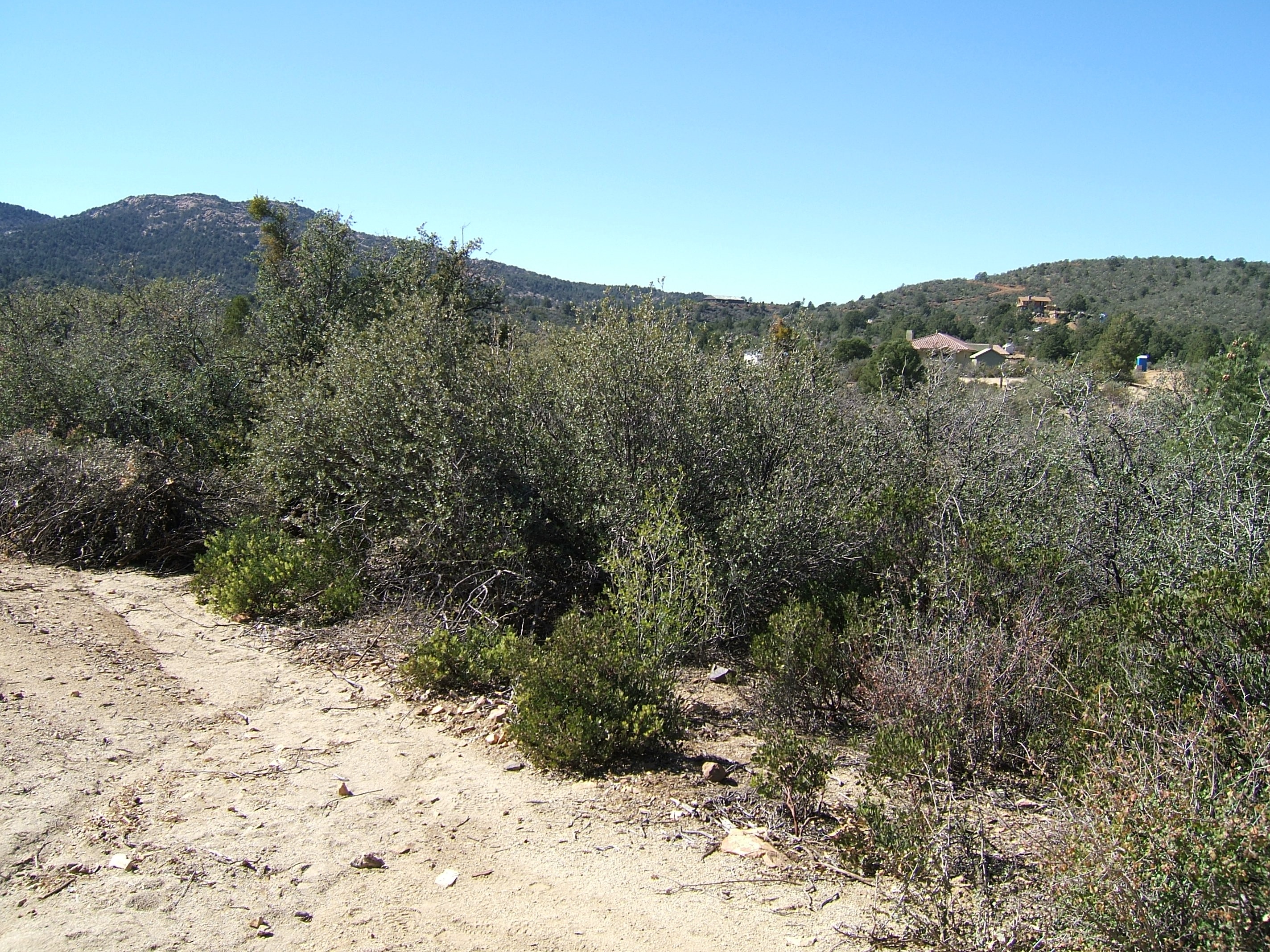 Arizona’s Interior Chaparral - December 4, 2019 Jeff Schalau, Agent, Agriculture & Natural Resources University of Arizona Cooperative Extension, Yavapai County The word “chaparral” is derived from the Spanish word “chaparro”, which means small evergreen oak, which itself comes from the Basque word “txapar”, with the same meaning. Today, chaparral is a word used to describe shrub-dominated plant communities of the western United States and northern Mexico. In Arizona, it is called “interior chaparral” and covers approximately 3.5 million acres. You may find areas of this unique vegetative community at elevations between 3,200 and 5,700 feet running between the northwest corner and the southeast corner of Arizona following the Mogollon Rim. The topography where it occurs is mostly on rough terrain dominated by moderately deep, coarse textured and/or poorly developed soils. California also has “coastal chaparral” plant communities which have similar plant growth forms and topography, but differs from the interior chaparral in species composition and climate. Many chaparral plants have one or more of the following characteristics: woody branches, leathery leaves, extensive roots, and high resin content. Yavapai County has thousands of acres of interior chaparral. Chaparral is often impenetrable to hikers and those that have tried to travel cross-country through chaparral may not want to repeat the experience or are otherwise gluttons for punishment. The most common species in Arizona interior chaparral is scrub live oak (Quercus turbinella) which often occurs in almost pure stands. Other common chaparral shrubs include: mountain mahogany (Cercocarpus ssp.), skunkbush (Rhus trilobata), sugar sumac (Rhus ovata), silktassels (Garrya spp.), desert ceanothus (Ceanothus greggii), hollyleaf buckthorn (Rhamnus crocea), cliffrose (Purshia mexicana), desert olive (Forestiera neomexicana), Palmer oak (Quercus palmeri), and multiple species of manzanita (Arctostaphylos spp.). At lower elevations, chaparral plants can also be spiny (Mimosa biuncifera and Acacia greggii). Arizona receives its precipitation in two seasons: winter and summer. This bimodal precipitation pattern causes Arizona chaparral plants to maintain somewhat consistent moisture contents. This is important when examining the timing and intensity of wildfires. Studies have shown the natural fire return intervals (the number of years between natural wildfire ignitions) in central Arizona chaparral were between 20 and 40 years prior to European settlement. A minimum of 20 years’ regrowth is required for it to re-burn. Since European settlement, fire suppression has kept chaparral from burning as frequently and has allowed deadwood to accumulate thereby increasing the intensity of wildfire when it occurs. This was the case with the Yarnell Hill Fire (2013) and the Goodwin Fire (2017). Following fire, many of the Arizona chaparral shrubs quickly resprout from established root crowns. In other plants such as Manzanita, fire stimulates germination of seeds (scarification) that have long been buried in the soil. Scrub live oak tends to remain spatially stable on sites where it grows. Fire and other major disturbances cause rapid resprouting/re-establishment. In studies of repeat photography, Arizona stands of scrub live oak that were present over 100 years ago persist in almost exactly the same height and spatial distribution we see today. Several wildlife species utilize chaparral vegetation for habitat. Big game species include javelina, deer, and bighorn sheep. Quail, vireos, towhees, and other ground dwelling bird species are also dependent on chaparral ecosystems for cover and food. Rabbits and small rodents as well as snakes and lizards are chaparral residents. Predators such as mountain lions, coyotes, bobcats, foxes, and various birds of prey can be found in chaparral looking for a meal. This may be somewhat challenging given the tangled limbs and thorny plants that create an almost impenetrable barrier. Chaparral areas are often used for rural home building sites and can pose serious wildfire risk if vegetation is not drastically reduced in density and distribution. In these settings, islands of chaparral are usually acceptable given they are 30 or more feet from any flammable structure. In these situations, a homeowner may decide to permanently kill a selected number of plants. Digging out chaparral plants is laborious and may be ineffective. Applying appropriate herbicides to cut stumps is an effective way to permanently kill unwanted plants and reduce wildfire risk in Arizona chaparral. See links below for additional information. You can follow the Backyard Gardener on Twitter – use the link on the BYG website. If you have other gardening questions, call or email the Master Gardener help line in the Prescott (928-445-6590/prescottmg@gmail.com) or Camp Verde (928-554-8992/verdevalleymg@gmail.com) and be sure to include your name, address and phone number. Find past Backyard Gardener columns or provide feedback at the Backyard Gardener web site: http://cals.arizona.edu/yavapai/anr/hort/byg/. Photo  A view of Arizona interior chaparral near Prescott, AZ (photo by: Jeff Schalau, University of Arizona.
A view of Arizona interior chaparral near Prescott, AZ (photo by: Jeff Schalau, University of Arizona.Additional Resources Yavapai County Native & Naturalized Plants, University of Arizona Cooperative Extension All plants mentioned in the above column are described in the "Shrubs" section https://cals.arizona.edu/yavapaiplants/ Wildfire Risk Reduction in Arizona's Interior Chaparral, University of Arizona Cooperative Extension extension.arizona.edu/sites/extension.arizona.edu/files/pubs/az1516.pdf |